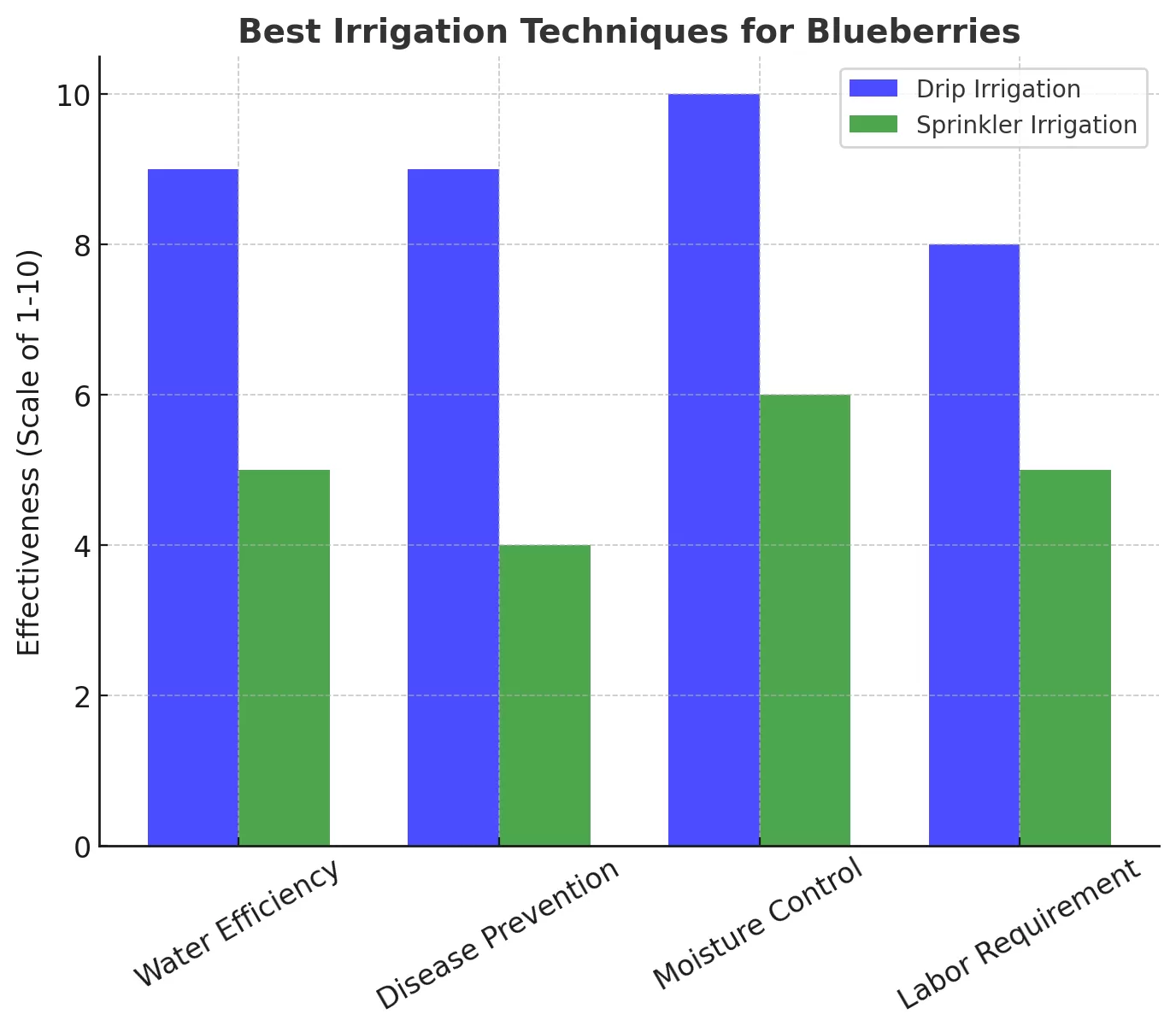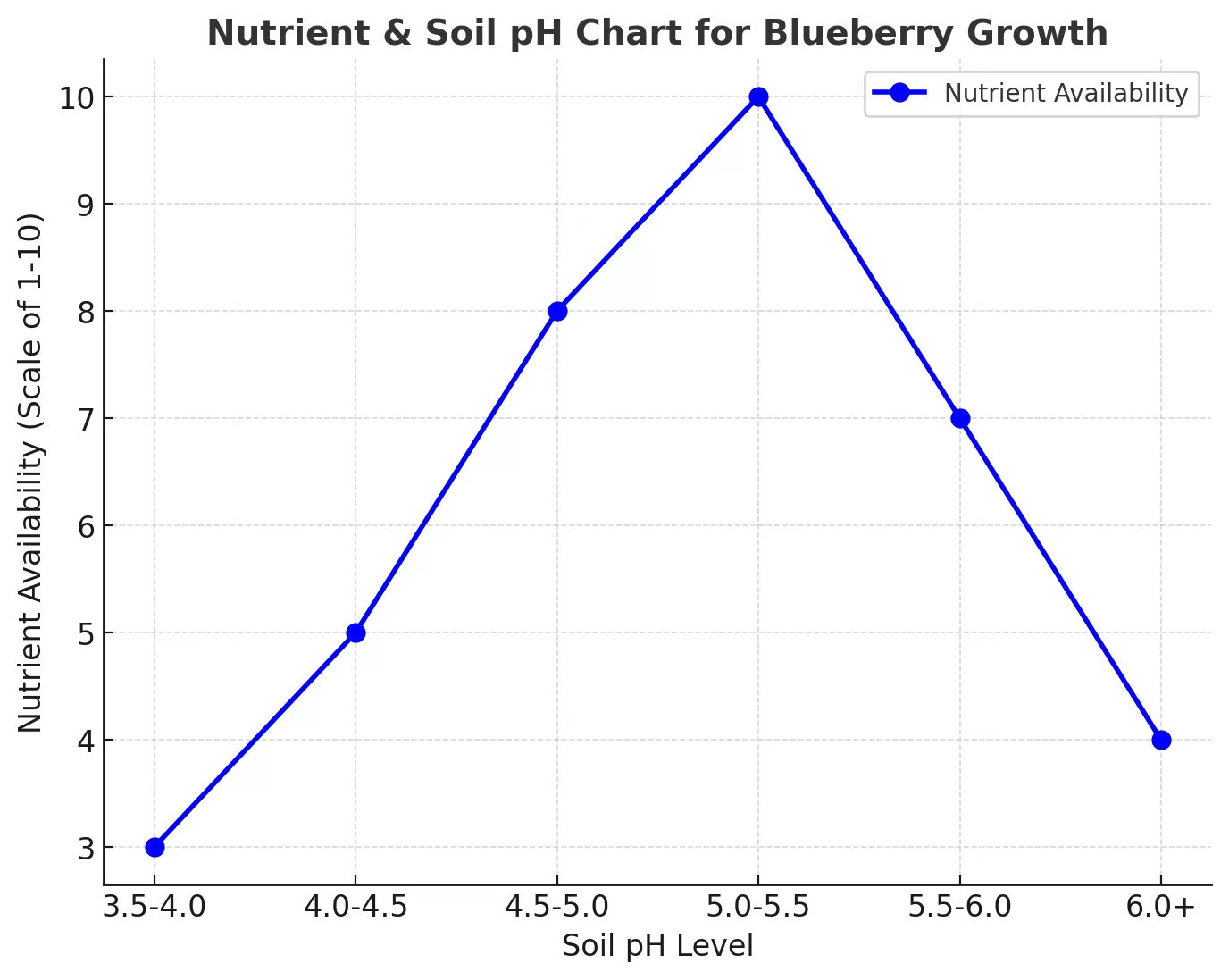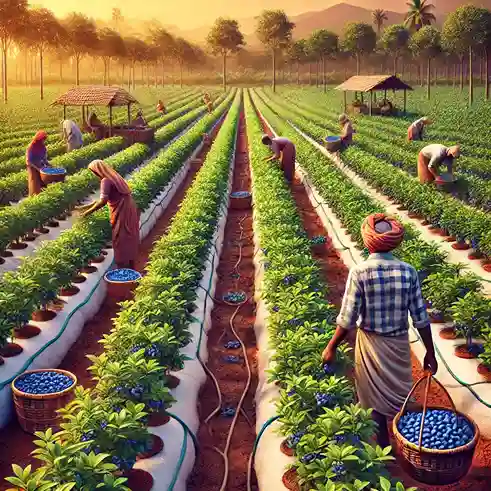Blueberry Cultivation in Maharashtra Using Cocopeat soil & Coconut Bricks
Blueberry Farming in Maharashtra
Blueberry farming is gaining popularity in India, particularly in states like Maharashtra, where the climate is conducive to controlled cultivation. Traditionally, blueberries thrive in acidic, well-draining soil, which poses a challenge for Indian farmers since most agricultural lands have alkaline or neutral pH levels. However, innovative growing media such as coconut bricks and cocopeat soil have made blueberry farming feasible in Maharashtra.
Cocopeat and coconut bricks offer improved aeration, moisture retention, and pH control, allowing blueberries to grow in conditions mimicking their natural environment. This article provides a detailed guide on blueberry farming in Maharashtra using cocopeat-based cultivation.
Understanding Blueberry Farming Requirements in Maharashtra
Climate Conditions
Blueberries require mild climates with chilling hours (exposure to temperatures below 7°C), but with new low-chill varieties, cultivation in Maharashtra has become feasible. The best growing conditions include:
✅ Temperature: 15°C – 25°C during the growing season.
✅ Sunlight: 6-8 hours of direct sunlight.
✅ Rainfall: Moderate rainfall (800-1000 mm annually).
✅ Humidity: 60-70% for optimal fruit development.
Soil and pH Requirements
-
Blueberries require acidic soil with a pH range of 4.5 – 5.5. Since most soils in Maharashtra are neutral to alkaline, using cocopeat soil and coconut bricks creates an ideal growing medium by maintaining the right pH and drainage.
Why Use Cocopeat Soil and Coconut Bricks?
Cocopeat soil and coconut bricks provide an excellent substitute for traditional soil due to their high water retention capacity, aeration, and ability to maintain an acidic pH.
Advantages of Cocopeat Soil and Coconut Bricks Usage
✅Responsible for maintaining acidity that is favorable for blueberries growth – Regulation of pH.
✅Prevention of moisture stress due to being able to retain water 5-7 times its weight – water retention.
✅Better roots oxygenation, which prevents root rot – Improved Aeration.
✅Sustainable as it is produced from coconut husk waste – Eco- Friendly.
✅Lower soil borne pathogens and pests – disease resistance.
Blueberry farming follows after cocopeat soil is prepared, along with the coconut bricks.
Hydration: coconut bricks should be soaked in water for half an hour so they expand fully.
Mixing: Perlite or sand should be added for better drainage along with cocopeat.
Adjustment of pH: Limit of 4.5- 5.5 can be achieved using sulfur or peat moss if required.
Container or bed preparation: Blueberries can be planted in this medium using containers or raised beds.

Cultivating Blueberries in Maharashtra Using Cocopeat Soil
Factors Influencing Blueberry Cultivation in Maharashtra:
Blueberry cultivation in Maharashtra is expanding beyond Mumbai, Pune and Nashik, with notable initiatives in regions like Devgad in the Sindhudurg district.
In Maharashtra, particularly in regions like Mahabaleshwar, blueberry cultivation has been explored as an alternative to strawberries, with potential yields exceeding 5 tonnes per acre.
Climate Adaptability: While blueberries traditionally require cooler climates, certain varieties have been adapted to thrive in Maharashtra’s diverse climatic conditions.
Innovative Farming Practices: Farmers are employing methods like low-cost tunnel farming to protect crops from extreme weather, enhancing yield and quality.
Soil Management: Utilizing growing mediums such as cocopeat and coconut coir bricks helps maintain the acidic soil conditions favorable for blueberries, even in regions with non-ideal native soils.
These developments indicate a growing interest and potential for blueberry cultivation across various parts of Maharashtra, driven by innovative agricultural techniques and adaptability to local conditions.
Government Support and Subsidies for Farmers:
- Available schemes and financial assistance for blueberry farming
- How Maharashtra farmers can benefit from agricultural incentives
Selecting the Right Variety
Since Maharashtra has a warm climate, opt for low-chill blueberry varieties, such as:
✅ Misty – Grows well in tropical conditions.
✅ Sharpblue – High yield, early fruiting.
✅ Biloxi – Self-pollinating and well-adapted to warm climates.
✅ Legacy – Produces sweeter berries, suitable for commercial farming.
Propagation and Planting
Blueberries can be propagated using seeds or cuttings, but cuttings are preferred for faster growth.
- Container or Raised Bed Farming: Use grow bags, large pots, or raised beds with cocopeat soil.
- Plant Spacing: Maintain 3-4 feet distance between plants.
- Mulching: Use pine bark or peat moss to retain moisture and suppress weeds.
- Drip Irrigation: Essential for keeping the cocopeat evenly moist.
Blueberry Plant Care and Maintenance
Irrigation and Water Management
Best Irrigation Techniques for Blueberries in Maharashtra 💧
Blueberries need consistent moisture to thrive, but overwatering or underwatering can harm plant health and reduce fruit yield. Using the right irrigation method is essential, especially when growing blueberries in cocopeat and coconut bricks, which have different water retention properties than traditional soil. Let’s explore the best irrigation techniques and practices to ensure healthy, high-yield blueberry plants in Maharashtra’s climate.
Drip Irrigation vs. Sprinkler Irrigation – Which is Better?
When choosing an irrigation system, drip irrigation and sprinkler irrigation are the two main options. However, for blueberries grown in cocopeat soil, one method is clearly better.
✅ Drip Irrigation (Best Choice for Blueberries)
Drip irrigation delivers slow, precise watering directly to the root zone using a network of pipes and emitters.
✔ Water-Efficient: Uses 50% less water than sprinklers, reducing wastage.
✔ Prevents Fungal Diseases: Keeps leaves and fruits dry, lowering disease risks.
✔ Ideal for Cocopeat: Provides controlled moisture without waterlogging.
✔ Saves Labor: Works on automation, reducing manual watering.
💡 Tip: Install drippers with adjustable flow rates (2-4 liters per hour) to match the water needs of blueberries.
🚫 Sprinkler Irrigation (Not Recommended for Blueberries)
Sprinklers spray water over a wide area, wetting the entire plant, including leaves and fruits.
❌ Leads to Fungal Issues: Constant leaf wetting increases the risk of mildew and root rot.
❌ Water Wastage: A large portion of water is lost to evaporation.
❌ Inconsistent Moisture: Some areas may get too much or too little water.
💡 Conclusion: Drip irrigation is the best method for watering blueberries, as it provides consistent moisture, prevents diseases, and reduces water wastage.
How to Maintain Proper Soil Moisture Using Cocopeat and Coconut Bricks
Blueberries grow best in moist but well-draining soil. Cocopeat soil and coconut bricks are excellent growing mediums because they:
✔ Retain moisture well, reducing frequent watering needs.
✔ Provide good aeration, preventing root rot.
✔ Help maintain an acidic pH, ideal for blueberries.
💡 Tips to Maintain the Right Moisture Balance:
1️⃣ Use Mulching: Apply pine bark or peat moss over the cocopeat bed to retain moisture and prevent evaporation.
2️⃣ Water Only When Needed: Stick a finger into the growing medium – if it feels dry 2 inches below the surface, it’s time to water.
3️⃣ Adjust Drip Flow Rates: During summer, increase water supply; during monsoon, reduce watering frequency.
4️⃣ Ensure Good Drainage: Use raised beds or containers to prevent excess water retention.
Best Watering Practices for Blueberries in Summer and Monsoon
🌞 Summer Irrigation Tips (Hot and Dry Months)
- Increase watering frequency to once or twice daily, depending on heat levels.
- Use shade nets to protect plants from extreme sun exposure and reduce moisture loss.
- Apply an extra layer of mulch to prevent soil from drying out too quickly.
- Monitor moisture levels closely to avoid drought stress.
💡 Tip: Water early in the morning or late in the evening to reduce evaporation loss.
🌧️ Monsoon Irrigation Tips (Rainy Season)
- Reduce irrigation to prevent overwatering and root rot.
- Ensure proper drainage by using slightly elevated beds or pots with drainage holes.
- Regularly check for fungal infections caused by excess moisture.
- Avoid wetting leaves to minimize disease risks.
💡 Tip: If heavy rainfall occurs, pause irrigation for a few days and let the growing medium dry slightly before resuming.
Fertilization and Nutrient Management
Since cocopeat is an inert medium, nutrients must be supplemented regularly.
✅ Nitrogen (N): Essential for vegetative growth (Use ammonium sulfate or organic fish emulsion).
✅ Phosphorus (P): Enhances root development.
✅ Potassium (K): Improves fruit quality and resistance to diseases.
✅ Micronutrients: Magnesium, Iron, and Zinc help with overall plant health.
✅ Organic Fertilizers: Vermicompost, seaweed extract, and composted manure enhance soil microbiota.
Ensuring the right amount of nutrients for blueberries is crucial for healthy growth and high yields. Overfertilization can harm your plants, affecting fruit quality and even causing root damage. Follow these simple steps to avoid excessive fertilizer use while keeping your blueberry plants thriving.
Pest and Disease Management
Since cocopeat reduces soil-borne diseases, common threats include:
✅ Aphids and Mites – Control using neem oil spray.
✅ Fungal Diseases – Use copper-based fungicides.
✅ Root Rot – Prevent by ensuring proper aeration and drainage.
Harvesting and Post-Harvest Management
Harvesting Time
✅ Blueberries are ready for harvest after 8-10 months post-planting.
✅ Fruits should be deep blue and detach easily from the stem.
✅ Harvesting is done manually to prevent bruising.
Post-Harvest Handling
✅ Sorting: Remove damaged or unripe berries.
✅ Packaging: Use ventilated clamshell containers for storage.
✅ Cold Storage: Maintain at 0-2°C for maximum shelf life.


Market Potential and Profitability in Maharashtra
Blueberries are in high demand in India, especially among health-conscious consumers and premium markets.
Market Opportunities
✅ Export Potential: Growing demand in UAE, Europe, and the USA.
✅ Local Demand: Used in desserts, jams, fresh fruit markets, and health supplements.
✅ Agro-Tourism: Blueberry farms attract visitors for fresh picking experiences.
Blueberry Yield and Profit Potential in Maharashtra
The yield of blueberries per acre in Maharashtra depends on factors such as variety selection, soil conditions, climate, and farm management practices. On a well-maintained farm using cocopeat and coconut coir as a growing medium, blueberry production can range between 5 to 10 tonnes per acre (5,000 to 10,000 kg).
Market Price in Maharashtra
The price of blueberries varies based on quality, demand, and availability in the local market. In Maharashtra, blueberries typically sell for ₹500 to ₹1,200 per kilogram in fresh fruit markets, premium grocery stores, and through direct farm sales.
Estimated Revenue Per Acre in Maharashtra
Using these figures, the potential earnings for a one-acre blueberry farm in Maharashtra can be calculated as follows:
✔ Lower Estimate: 5,000 kg × ₹500 per kg = ₹25 lakh per acre
✔ Upper Estimate: 10,000 kg × ₹1,200 per kg = ₹1.2 crore per acre
Thus, blueberry farming in Maharashtra offers an estimated revenue potential ranging from ₹25 lakh to ₹1.2 crore per acre, depending on yield, farming methods, and market conditions.

Challenges and Solutions in Blueberry Farming
|
Challenge |
Solution |
|
High Initial Investment |
Use government subsidies and loans for setup. |
|
Maintaining Soil Acidity |
Regularly check and adjust pH using sulfur or pine bark mulch. |
|
Pest and Disease Control |
Use organic pesticides like neem oil and beneficial insects. |
|
Limited Knowledge |
Attend training sessions and workshops on hydroponic farming. |
The Future of Profitable Blueberry Farming in Maharashtra
Blueberry farming in Maharashtra using cocopeat soil and coconut bricks is a profitable and sustainable venture. With the right variety, soil management, irrigation, and marketing strategy, farmers can achieve high yields and premium prices. Investing in blueberries as a high-value crop can transform Maharashtra’s agricultural landscape, making it a leader in exotic fruit farming. Additionally, working with a reliable coconut brick manufacturer ensures a consistent supply of high-quality growing medium, enhancing productivity and long-term success.
By following the steps and tips outlined above, you can embark on your blueberry farming journey with confidence. Whether you are a small-scale gardener or a commercial farmer, this method offers a promising path to cultivate blueberries profitably in Maharashtra. Embrace the power of cocopeat and coconut coir bricks – your blueberry plants will thank you with plump, delicious berries come harvest time!

